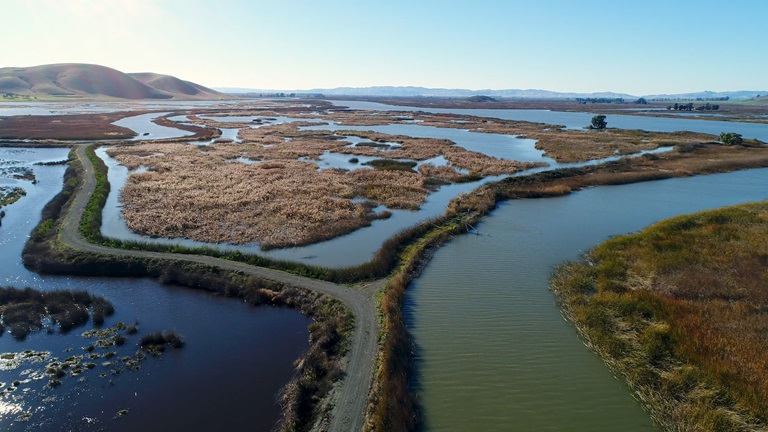DWR Awarded Prop 1 Grant to Study Removal Methods of Highly-Invasive Plant in Suisun Marsh
The common reed (Phragmites australis) is one of the most invasive plants in the world, and it is widespread in part of the Sacramento-San Joaquin Delta. Phragmites reduces biodiversity in tidal wetlands by aggressively outcompeting native plants, negatively impacting habitat for native wildlife. 
The Department of Water Resources (DWR) will begin a study this October to determine the effectiveness and environmental impacts of various ways to control a highly invasive plant species in the Sacramento-San Joaquin Delta.
The common reed, Phragmites australis, is one of the most invasive plants in the world, and its numbers are widespread in Suisun Marsh. Phragmites reduces biodiversity in tidal wetlands by aggressively out competing native plants.
Phragmites can change ecosystem structure by increasing tidal habitat elevations and reducing overall habitat quality, including disturbing the food chain by driving out native plants in the Delta that support wildlife such as waterfowl and the endangered salt marsh harvest mouse.
In recent years, the presence of phragmites in the Delta has gone up dramatically – between 1999 and 2015, the area of Suisun Marsh dominated by phragmites has increased by 325 percent.
Earlier this year, DWR was awarded a $387,400 grant through the Delta Conservancy’s Proposition 1 Ecosystem Restoration and Water Quality Grant Program to study various phragmites removal methods.
“We are grateful that we were awarded the Delta Conservancy Prop 1 grant to conduct this important study,” said Gina Darin, DWR senior environmental scientist and supervisor of the research team. “We have a lot of local support and are excited to work with our partners to conduct this research.”
DWR is conducting the study at the Blacklock Restoration site in the Suisun Marsh, which became a tidal wetland in 2006. When it was flooded, areas dominated by short-stature herbaceous vegetation converted to mudflats, resulting in little vegetation on site, so phragmites was able to spread quickly, with little competition from the remaining native species. Today, phragmites covers the majority of the wetland, with little native habitat remaining.
DWR will test a combination of phragmites control methods, including the use of mechanical mowing, and the use of two herbicides – Rodeo and Habitat. Researchers will test Habitat on its own as well as test a mixture of the two herbicides together.
The study will measure each method’s effectiveness and impacts to neighboring plants, water quality, and the aquatic food web.
“DWR aims to assess the efficacy and environmental impacts of phragmites control methods,” said Krista Hoffmann, DWR environmental scientist and Blacklock Phragmites Control Study project manager. “The goal of the project is to test multiple tools in our toolbox to determine which method is the most effective and least environmentally damaging.”
The Prop 1 grant provides DWR with the necessary funding to test with the latest technologies, including using multi-spectral imagery collected by unmanned aerial vehicles to monitor the effectiveness of each control method and the spread of the weed across the test site.
“Controlling phragmites will prevent further degradation of tidal habitat, allowing the native plant community to recover, and provide a habitat for a diversity of native wildlife,” said Cliff Feldheim, DWR environmental program manager and chief of DWR’s Suisun Marsh Branch.
The study is a team effort. DWR will work with UC Cooperative Extension and Solitude Lake Management, with local support from Suisun Resource Conservation District and Solano County.
